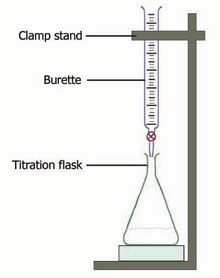How to determine Iron concentrations in chem IA? To determine Iron concentrations in chem IA,You can use redox titration method between the sample (fruit or vegetable extract or Iron compound)and Potassium permanganate solution.
During the titration between your sample and KMnO4 solution the chemical reaction will take place as per following mole ratio:
5Fe2+(aq) : MnO4 (aq)
5Fe2+(aq) + MnO4 (aq) + 8H+(aq) → 5Fe3+(aq) + Mn2+(aq)
Thus with the help of standard solution of KMnO4 solution you, can calculate the concentration of Iron in your sample.

You can go through the following Sample IA of One of my student.
Research question: To find iron (II) [Fe2+] concentration (mol/l) of the apple juices?
Background Information:
Apple is a fruit of the domesticated tree Malus domestica. Apples vary between in each other in different aspects: acidity, shape, size, flavour and shade (red, yellow, green or mixture of colours).Mostly composed of water – 85%, carbohydrates – 13%, dietary fibre – 2% and other minerals, which includes iron.
Iron (Fe) is the transition metal of Group 8 of the periodic table. Iron is one of the essentials minerals for the human body. It is necessary for the production of haemoglobin, a protein in the blood which carries oxygen throughout the body and required for cell growth and differentiation. Iron in apples is non-heme iron (plant iron). 100 grams of an apple contains on average 0.12 mg (moles) of iron.
Iron (Fe2+) is oxidized by potassium manganate (KMnO4) (VII) to Iron (Fe3+). By this redox titration reaction, the iron concentration of apples can be calculated. Redox reaction half equations:
MnO4– + 5Fe2+ + 8H+ -> Mn2+ + 5Fe3+ + 4H20
As seen from equation, reaction only occurs when iron(II) is present since it can be oxidized further. As a result, all of Fe3+present in apple juice must be converted to Fe2+to get proper results from the experiment: to measure total concentration of iron. Therefore, juice will be mixed with an excess of the mild reducing agent, hydroxylamine hydrochloride (NH2OH · HCl), to turn Fe3+to Fe2+ :
4Fe3+ + 2NH2OH · HCl —> 4Fe2+ + N2O + 4H+ + H2
If you need personal guidance and one to one meeting, send us email at info@chemswot.com

Hello,
I am doing something quite similar regarding how cooking tomato sauce in an iron skillet will increase the sauce’s iron content. To calculate the iron content, I was thinking of using the procedure you have described; however, I am unsure how to add the hydroxylamine hydrochloride (NH2OH · HCl) to the tomato paste to change all Fe3+ to Fe2+. In addition, after doing so, how do I titrate/know the endpoint?
Your input would be very helpful, thank you in advance!
Dear Leen,
You can take the saturated solution of tomato sauce and add it carefully to hydroxylamine hydrochloride solution as per your trials. You can use EDTA solution for the titration and record the end point using colour change. Hope it will help you.
Stay Blessed!
All the best for your IA.
Dr Anup Sharma
Would you be able to use sulphuric acid to dilute the food instead of the hydroxylamine hydrochloride solution? Also If I were to use a vegetable like spinach or peppers how would I be able to turn it into a solution thats able to use?
You can use however sulphate ions can interfere.
Could I ask how the sulphate ions would interfere?
It is generally not recommended to use sulfuric acid in place of hydroxyl amine hydrochloride when determining the iron (II) concentration of apple juice or any other sample. This is because sulfuric acid and hydroxyl amine hydrochloride have different chemical properties and react differently with iron ions.
Hydroxyl amine hydrochloride is often used as a reducing agent in analytical chemistry procedures to reduce iron (III) ions to iron (II) ions, which can then be quantified using spectrophotometric methods. On the other hand, sulfuric acid is a strong acid that can react with many different types of compounds, but it is not typically used as a reducing agent.
If you are trying to determine the iron (II) concentration in apple juice, it is generally recommended to use a method that involves the use of hydroxyl amine hydrochloride or a similar reducing agent, rather than sulfuric acid. It is also important to carefully follow the instructions provided by the method and to use appropriate safety precautions when working with chemicals.
How would I change Fe3+ to Fe 2+ on vegetables
Vegetable extract should be mixed with an excess of the mild reducing agent, hydroxylamine hydrochloride (NH2OH · HCl), to turn Fe3+to Fe2+
Equation: 4Fe3+ + 2NH2OH · HCl —> 4Fe2+ + N2O + 4H+ + H2
Thank you
Are the states symbols correct
4Fe3+(aq) + 2NH2OH · HCL(aq) → 4Fe2+(aq) + N2O(g) + 4H+(g) + H2(g)
4H+ ions are (aq).
Thank you so much
Also after when I titrate it how will I determine the titration like how will I know how much iron is present, do I need an indicator or something. Thanks
Use the equation and stoichiometric coefficient to calculate the iron content.
where does the mole ratio between 5Fe+2:MnO4 come from? Is the coefficient of Fe+2 5 regardless of the mass of the ash of the vegetable sample?
equation implies that 5 moles of Fe^2+ react with 1 mole of MnO4^- in the presence of 8 moles of H^+ ions.
Now, regarding the coefficient of Fe^2+, it is indeed 5 in this balanced equation. The coefficients are determined by the stoichiometry of the reaction and represent the ratio in which substances react. So, regardless of the mass of the ash of the vegetable sample, if the reaction involves 5 moles of Fe^2+, that’s the coefficient you use in your mole ratio calculations. The mass comes into play when converting between moles and grams using the molar mass of the substances involved.
Hey I do the similar experiment. I try to determine the iron concentration in greens like spinach. But I cannot determine the end point. My acid is H2SO4 (3M) the indicator is KMnO4 (0.01M) and my independent variable is different greens. But I am having trouble in determining when the endpoint is. Every time the solution turns pink, it goes back to clear two minutes later. How can I determine the endpoint? Or should I use a different indicator or something?
Hi,
Change the Indicator: Consider using a different indicator that might be more stable in your reaction conditions. Phenolphthalein is commonly used in acid-base titrations, but it might not be the best choice for redox reactions like this one. Ferroin or o-phenanthroline are alternatives worth exploring.
Decrease Concentration: You could try reducing the concentration of your KMnO4 solution. Sometimes a less concentrated solution can lead to a more stable endpoint.
Slow Down Titration: If your reaction is proceeding too quickly, slowing down the rate of titration might help. You can do this by adding the KMnO4 dropwise or even diluting your sample.
Use Starch as an Indicator: Starch-iodine complex can be a good indicator for the endpoint in redox reactions involving iron. Just be cautious not to add too much starch, as it can interfere with the reaction.
Extend Reaction Time: Allow more time for the reaction to reach completion before declaring the endpoint. Sometimes reactions take a bit longer to stabilize.